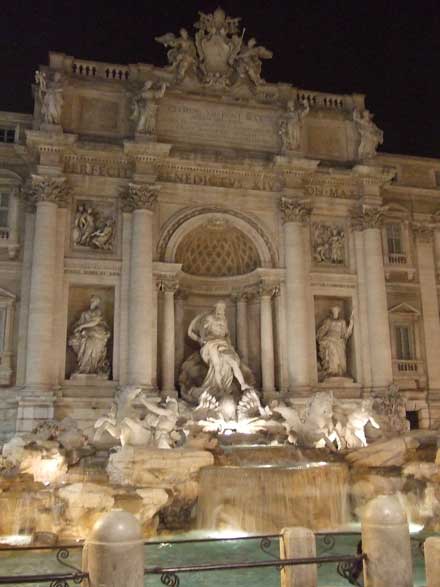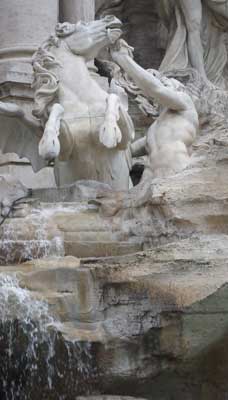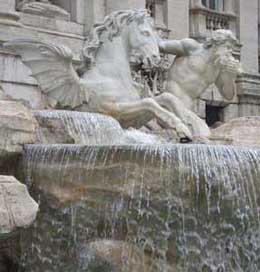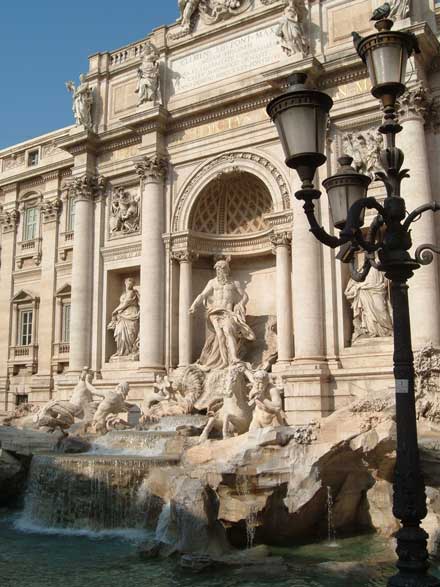The Trevi Fountain (Fontana di Trevi) is one of Rome’s most famous tourist sights; an overpowering spectacle which dominates its surroundings.
Generally the city of Rome is large enough to absorb its tourist visitors with ease. There are just a few places in Rome where you can find yourself barely able to move for camera-wielding crowds or clutching your bag for fear of pickpockets. Unfortunately the Trevi Fountain is one of those places. However, it is still an unmissable sight when you are visiting Rome, especially if you are lucky enough to arrive when the crowds have lessened.
One of the reasons for the crowds is simply the lack of space. What photographs don’t convey, and what strikes the visitor most powerfully, is the fountain’s scale compared to its setting. This is a simply massive, monstrous water feature built in a tiny square. It incorporates one side of the piazza; the entire facade of a palazzo. The water thunders and it is one of the most staggering, ludicrously theatrical spectacles you will ever see. It is an exuberant expression of Rome’s character in all its excess, extravagance and drama. Brush off the hawkers trying to sell plastic rubbish, hold tightly to your valuables and find a vantage spot where you can simply stand and take in the view, and the sound of the thundering water.

A fairly recent ‘superstition’ (possibly contrived by an early incarnation of the tourist board) says that if you throw a coin into the fountain, you are destined to return to Rome. Different countries and guidebooks give different instructions and we once spent an interesting few minutes observing the variations: over the shoulder, eyes closed etc. An enterprising chap used to wade in overnight and help himself to the coins; he was eventually taken to court. Frequently drunk foreign tourists decide to re-enact La Dolce Vita: they are liable to arrest and large fines.
The water for the Fontana di Trevi comes from an ancient underground Roman aquaduct built by Agrippa, the Acqua Vergine. It also supplies water to the fountains in Piazza Navona, the Piazza di Spagna and Piazza Farnese.
There was a simpler fifteenth-century water basin here when Pope Clement XII held an architectural competition for a new fountain in 1732. The contest was won by Niccolo Salvi, who was also a poet. He died before the fountain was finally completed in 1762.

The fountain’s backdrop is Palazzo Poli, which becomes a part of the monument. The fountain features a central sculpture of Neptune, with Health and Abundance alongside. He is attended by tritons and marine horses.
When I stayed by the Trevi Fountain at the Relais Fontana di Trevi, I found that the only really quiet times by the fountain were between midnight and early morning. There are municipal police on duty all the time, to protect the monument, to stop drunk tourists diving in and to prevent thieves from stealing the coins in the fountain. Around 8am on a Wednesday morning I found council employees at work ‘vacuuming’ up coins from the bottom of the shallow water, with the fountain silent, so if you want to see an unusual view of the famous sight, this could be a good time to pay a visit – especially if you stick around until the moment when the fountain is switched back on.

The Trevi Fountain on film
The fountain is one of the characters in that most famous Rome film scene: Marcello Mastroianni and Anita Ekberg in Fellini’s La Dolce Vita. You can buy posters of this scene all around Rome, including at many stalls along nearby lanes. The fountain also, of course, plays a significant part in Three Coins in the Fountain, a flimsy but pretty 1950s film crammed with Roman scenery.
More fountains
Rome is famous for its many fountains, but if you like the drama of the Trevi Fountain, try taking a day trip to Tivoli and seeing the water-gardens of the Villa d’Este.
On this site
